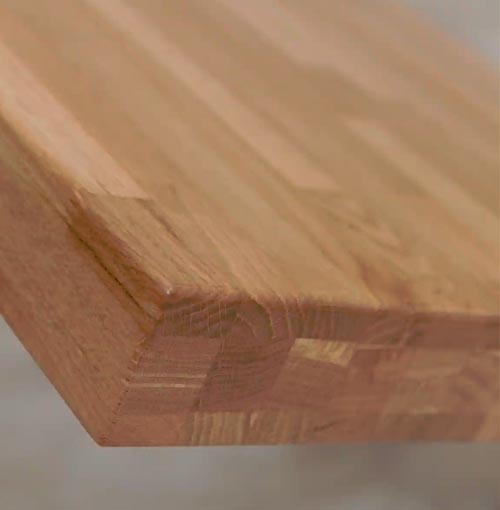
We use high-precision machinery and strictly follow specific steps to make the multilayer solid hardwood panels. Here are the steps we take:
We choose high-quality hardwood veneers for the face layers and for the inner layers we will use the adequate core material (softwood, plywood, or particleboard). We use oak for the veneers.
Once we selected the hardwood veneers, we use Weinig Opticut 260 for trimming the veneers to size. We also sort them according to grain pattern, color, and quality. The finished panels will have a uniform appearance in the end.
To cut the core material to the needed dimensions we employ the WEINIG VarioRip 310. It's a rip saw that ensures precise cutting of the material. When we use plywood or particleboard cores, we address all flaws and irregularities before cutting.
We use high-strength adhesive to glue the face veneers onto both sides of the core material. We place the veneers with the grain direction perpendicular to each other and to the core material. This way, the panels will be strong and have a low risk of warping.
We use ProfiPress L II 2500 gluing press to assemble the glued veneers and core material into a sandwich-like structure. We alternate layers of veneers and core material. The pressure will be applied evenly across the assembly to eliminate air pockets and obtain perfect bonding.
One person will operate the machinery that does automatic feeding of lamella, glueing and pressing. It uses high radio frequency to heat the glue lines and speed up the curing. The machinery protects the wood from heating and only heats the glue lines. The gluing is precise and the waste of glue is minor.
The pressed panels will cure for the proper amount of time, until the adhesive cures entirely and bonds the layers together. This step is essential to ensure the structural integrity of the finished panels.
They pay attention to the most minute detail when examining the finished panels. We make sure that the multilayer solid hardwood panels meet the needed specifications for appearance, dimensions, and structural integrity.
Multi-layer solid hardwood panels present improved stability when compared to traditional solid wood panels. Thanks to the alternating grain direction of the veneer layers and the use of stable core material, the effects of wood movement due to changing temperature and humidity are low. The panels have a low risk of warping, cupping, or cracking and can be used where solid wood isn’t practical.
The profile is thinner compared to solid wood panels, but multi-layer solid hardwood panels are made to be strong and long-lasting. The bonding process generates a solid and cohesive structure that takes everyday use in flooring, furniture making, and cabinetry.
Multi-layer solid hardwood panels show consistent dimensions and have a uniform appearance. They are easy to work with and give a seamless finish to woodworking projects. They ensure excellent flexibility in large-scale applications.
Versatility is another characteristic as multi-layer solid hardwood panels can be used for flooring, cabinetry, furniture making, wall paneling, and architectural millwork. The panels feature natural wood grain patterns and colors so they add warmth and character to spaces.
We maximize wood resources as we use thin layers of solid oak and beech wood for the face layers. The amount of hardwood needed is less than with solid wood panels. We use hardwood from sustainably sourced materials and multi-layer hardwood panels are environmentally friendly.
The most common applications for multi-layer solid hardwood panels are:
Flooring
Multilayer solid hardwood panels can be used as flooring material in residential, commercial, and institutional buildings. Thanks to their stability and resistance to moisture, they can be used in areas where traditional solid wood flooring isn’t adequate (basements and areas with changing humidity levels).
Cabinetry
The construction of kitchen cabinets, bathroom vanities, and storage units can be made with multilayer solid hardwood panels. They are strong and have excellent dimensional stability and can withstand heavy loads and intense daily use.
Furniture making
Tables, chairs, bookcases, dressers, and various furniture pieces can be made with multilayer solid hardwood panels. They are beautiful, warm, and strong and are popular for functional and decorative furniture pieces.
Wall paneling
When used as wall paneling, multilayer solid hardwood panels will bring warmth, texture, and a nice appearance to the interior space. The surface is aesthetically pleasing, long-lasting, and can be finished in many styles according to the design scheme.
Architectural millwork
The hardwood panels can be part of architectural features such as window frames, doors, and moldings. Thanks to their dimensional stability and uniformity, the panels are useful for intricate details and profiles.
Decorative elements
We run a precision-driven process so that the hardwood panels can be used for decorative elements such as coffered ceilings, wainscoting, and built-in shelving units. Designers and architects will obtain the desired aesthetic without losing the structural integrity as the panels are strong, versatile, and easy to use.
Retail and hospitality
Multilayer solid hardwood panels can be used in retail stores, hotels, restaurants, and various commercial spaces to obtain welcoming interior spaces. They bring the warmth and beautiful appearance of natural wood and are ideal for high-traffic areas as they are durable and easy to maintain.
Renovations and remodeling
Many people interested in renovations and remodeling projects use multilayer solid hardwood panels. They are adequate to install over current walls or subfloors. They are also a cost-efficient option to update the interior spaces.